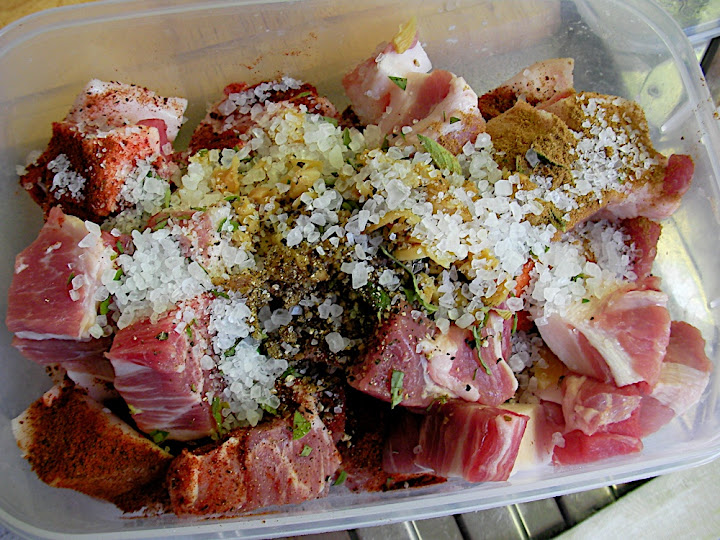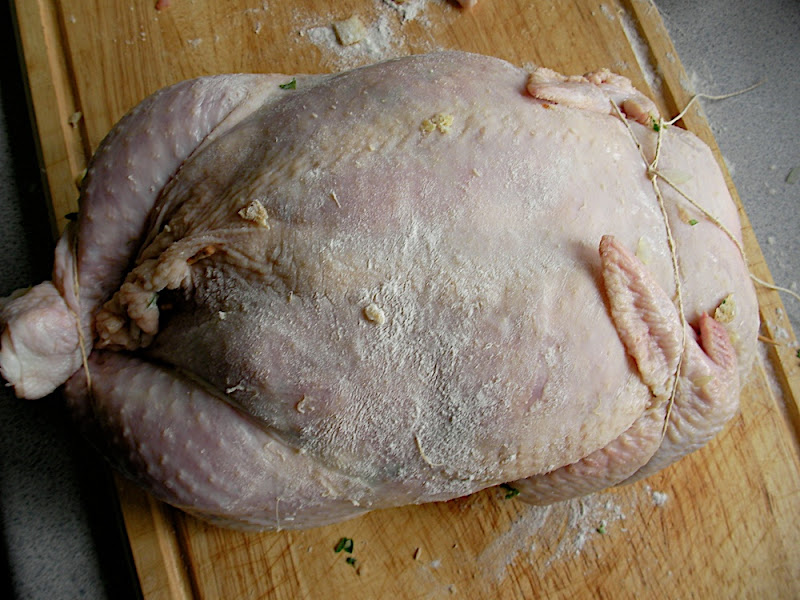Emily from Malaysia asked me for a good chicken liver pâté recipe. Pâté is not something I make very often, as it tends to go crumbly if you freeze it and it's very fattening so I can't eat a whole batch all by myself if I still want to fit into my clothes. I don't know where I got the recipe I use, it was some time back in the 70s, and it's so simple I haven't needed to look at it since the first time I made it! It's also very easy to modify so I'm giving two versions here, and seeing as I bought some chicken livers I'm also making a pâté (somewhat modified) from
Michael Ruhlman and Brian Polcyn's Charcuterie - because I want to see what it tastes like.
Here's what I bought at the supermarket:

That's about 250 g each of chicken livers, boneless chicken thighs, and pork belly strips. I'm making very small portions of each of the patés, for the sake of my waistline.
For the first chicken liver pâté, which is the basic version, I started off by putting 100 g of chicken livers, a few black peppercorns, a bay leaf, and a sprig of parsley into a small pot and barely covering with water.

I poached the livers gently until they were just cooked - about 10 minutes, but you can break open a liver to check its cookedness.

Then the liver and parsley went into my tiny processor - the one that came with my stick blender - with 50 g of butter, half a small onion, and a clove of garlic. I used smoked garlic because I have some and I love it, but just plain old raw garlic is fine..

I whizzed it up until it was very smooth, then added salt and ground black pepper to taste. You just stick your finger in and taste it, it's already cooked. You want to salt it quite well, because it'll taste less salty once it's cold.

Then all that's left to do is pack it into a dish, let it cool, then cover it with plastic wrap and put it in the fridge.

If you want serve it turned out of the mould, you can line it with plastic wrap before filling it with the pâté, but I quite like to serve it in a pot like this.
In number two version of the pâté I fry the livers instead of poaching them. In this case I'm frying them in goose fat, because I had some in the fridge, and I want to see what the paté will be like using poultry fat instead of butter. This is actually very similar to the Jewish dish of chopped liver.

So that's 100 g chicken livers, each one cut into about six pieces, fried in 50 g goose (or chicken or duck) fat. When they were done, I put them in the wee processor, then I fried half a small onion in the fat as well. I decided against putting garlic in this one.
I put the onion, fat, some freshly ground black pepper, and 1/2 teaspoon of salt into the processor with the livers and whizzed it up.

Then it went into a wee pot too.

It's a little less smooth than the poached version.
The pâté from Charcuterie is a great deal more complicated than those two, and I halved the recipe.
I started off by skinning the pork strips and cubing the pork and chicken (this was supposed to be just pork shoulder in the recipe) …

… which then went through the coarse die of my mincer:

One third of this coarsely minced meat went into a separate bowl to which I added three cloves of smoked garlic, a good bunch of parsley, some black pepper, and some pâté spice (a mixture of cinnamon, ginger, cloves, nutmeg, white pepper, and coriander). I was supposed to put a chopped onion in there too, but I saved it to chase this stuff down the mincer with.

That all went through the mincer's small die, into the bowl with the coarsely ground meat. The onions went down the mincer last, to push through the last bits of meat. I don't care if a bit of onion gets left behind in the mincer, but I do care if it's meat.
The salt was added at this point.

Next thing to do was mix a panade. It was made from an egg, some flour, some brandy, and some cream. Again I didn't do what I was supposed to - it was supposed to be heavy cream, but I used the top of the milk I get for cheesemaking. Much lighter. Slightly less fattening.

Then I mixed the panade in with the meat mixture.

You beat it for a minute or so until it gets sticky - a bit like kneading bread.
Once it was well beaten I mixed in some capers I had in the fridge. The book says to mix in whatever you have that'd be nice, suggesting cooked mushrooms, brined peppercorns, or duck confit. I don't have a lot of duck confit lying around the place, so I used capers. You don't
need to use anything though.

I was a bit concerned about the next step - lining the cooking dish with plastic wrap. I was not at all sure it wouldn't melt in the oven, but I gritted my teeth and followed instructions, wetting the dish so the plastic would stick to it. Then I packed it with the pâté mixture …

… and covered that with the tails of the plastic.

On with the lid and into the 150°C oven in a bain marie.

I cooked it until its internal temperature was 70°C, which took longer than I expected, around an hour and 20 minutes.
The plastic didn't melt! They do know what they're talking about after all.

I pressed it overnight with a couple of kg weight on top.

Then turned it out in the morning. How nice does this look?

Here it is all sliced up, looking very attractive studded with the green capers:

I've frozen some of it, we'll see how the texture goes when I defrost it. Some of it is in the fridge waiting to become lunches, and I had to try some too.
I baked myself a small loaf of sourdough bread this morning so I'd have something to eat the pâtés with.

That stuff on top of the right hand slice of toast and pâté is marmalade. I'm very fond of pâté with marmalade, an idea I got some years ago from a local deli who were giving out tastes of pâté with candied citrus slices. Marmalade is basically candied citrus, and a lot easier to make, so I tried it and loved it and have eaten chicken liver pâté thus ever since. It's also nice with a squeeze of lemon juice instead of marmalade; the pâté is very rich, so a bit of tartness helps cut the fattiness.
Oh, and the pâté from Charcuterie? It's heavenly.
RecipesBasic chicken liver pâtéIngredients:about 200 g chicken livers
1/2 the weight of the livers in butter
a bay leaf
a few peppercorns
big sprig of parsley
salt to taste
freshly ground black pepper
2 cloves garlic
small onion
Method:Put everything except the onion, garlic, butter, ground pepper and salt in a small pot and barely cover with water.
Simmer very gently until the livers are cooked, about 10 minutes.
Drain the livers and transfer them and the parsley to a food processor.
Add the rest of the ingredients except the salt.
Whizz until very smooth. Taste, and add salt until it is slightly too salty - it will taste less salty when it's cold.
Scrape into a small serving dish, cool, refrigerate.
Variations: Use duck, goose, or chicken fat instead of butter. Replace up to a third of the liver with chicken thigh or breast meat. Fry in the fat instead of poaching; this gives a stronger flavoured pâté. Use more or less garlic, depending on how much you like it. You can use less fat; the texture will be less smooth, but it'll be better for you - I've made it with as little as 1/4 the weight of livers in butter.
Pâté Campagne (from
Charcuterie)
Ingredients:1 kg boneless pork shoulder, diced (I used a mixture of pork belly and chicken thigh meat)
100 g pork or chicken liver
50 g chopped white or yellow onion
50 g coarsely chopped flat-leaf parsley
25 g minced garlic
25 g kosher salt
1 tsp freshly ground black pepper
1/2 tsp pâté spice*
20 g flour
2 large eggs
30 ml brandy
1/2 cup heavy cream
optional internal garnish - anything you have that might be nice, cooked chopped mushrooms, brined peppercorns, duck confit etc
* 1 tsp each of ground ginger, coriander, cloves, nutmeg, 2 tsp cinnamon, 1 tbsp white pepper.
Method:Keep everything very cold, including the mincer. (I was a bit slack about this, didn't seem to hurt it too much)
Pre-heat oven to 150°C
Grind the pork through the large die a bowl set in ice.
Transfer about 1/3 of this to another bowl, and add the liver, onion, parsley, garlic, salt, pepper, and pâté spice.
Fit the mincer with the small die, and grind the pork-liver-seasonings mixture into the bowl of coarsely ground pork.
In a small bowl, combine flour, eggs, brandy and cream and stir to blend.
Add this to the meat mixture and mix until it becomes sticky like sausagemeat. You can use an electric mixer with the paddle attachment, or a wooden spoon. Fold in the optional garnish, if using.
Do a quenelle test (poach a tiny bit of the mixture wrapped in plastic wrap and taste it) to check the seasoning and adjust if necessary.
Line a 1.5 litre terrine mould with plastic wrap, leaving enough overhang on the long sides to fold over the top of the terrine when it's filled.
Fill the mould with the pâté mixture, packing it down to remove air pockets.
Fold the plastic over the top, and cover with the lid or foil.
Place the terrine in a high-sided roasting dish and add enough water to come halfway up the sides of the terrine.
Put the pan in the oven and bake until the interior of the pâté reaches 65°C if using pork liver, or 70°C if using chicken livers. About 1 hour.
Remove from the oven, remove the terrine from the bain marie, and set a weight of about 1kg on top of it.
Let cool to room temperature, then refrigerate until completely chilled, overnight, or for up to a week.
Yield 10-12 entrée (appetiser to Americans) servings.








































































